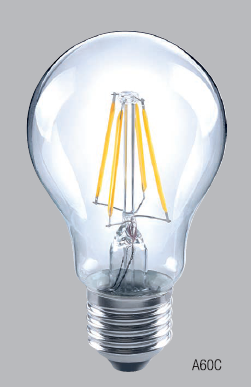Within the LED lighting industry, more and more companies shifted their focuses to niche markets and specialty lighting to get away from bitter price wars in the general lighting market. Sectors such as horticultural lighting, healthcare, shipping, and intelligent lighting began to witness the emergence of LED products, and it also seemed a definite trend to replace traditional low-price LED tubes with advanced high efficient ones. As for the decorative lighting market where consumes a massive amount of LEDs, it also experienced a series of changes when LED technology gradually takes hold. In light of the fact that it has earned a favourable reception among traders, distributors, and lighting designers, LED filament soon became considerably desirable to replace conventional low wattage LED bulbs and LED candle bulbs producing high thermal runaway. Accordingly, in recent years, LED filament has been a great hit in the market.
 |
|
(Photo Credit: Epistar ) |
Massive Demand for Decorative Lighting Scales up the LED Filament Market
Filament LED candle bulbs and other filament products can already be seen in decorative lighting in churches, commercial locations, restaurants and hotels, reflecting its escalating penetration. In the eyes of designers, consumers, and clients, LED filaments outperform traditional LED bulbs and the last generation LED candle bulbs in terms of design, light uniformity, the aesthetics of space, and creating vintage feels.
With the declining price of LED chips, the market already foresaw the potential of LED filament early in 2015. Last year, the overall demand from markets around the globe escalated drastically. LED filaments with luminous flux under 450lm are likely to receive a tremendous amount of orders from distributors and replacement requests from the decorative lighting sector.
Leverage the Brand with Technology and Intellectual Properties
Epistar is one of those corporations first stepping into the LED filament market at the early stage. Far back in 2007, the company began to leverage its share with the intellectual properties it held. Through the interview with Max Lin, and Luke Lu, Project Directors from Epistar, LEDinside has a grasp of their experience collaborating with business partners and their ongoing effort invested in LED filament development. All has helped structure the current and future dynamics and the IP development of LED filaments.
Epistar owns a comprehensive IP portfolio regarding LED chips and partial structure of LED filament, said Director Lin. Via licensing IPs to mid- and downstream manufacturers in different markets, Epistar also helps customers raise their competitiveness level.
 |
|
Luke Lu and Max Lin, Project Directors from Epistar (Photo Credit: LEDinside) |
In China, Epistar mostly partners with LED packaging companies and manufacturers producing LED bulbs domestically while selling their products overseas. Those aforementioned, starting their business of making incandescent lamps, hold a great bundle of know-hows and are capable of mass production of lighting bulbs. For the manufacture of LED filament mainly with glass housing, they play a crucial role in the supply chain. The collaboration with Epistar further grants them more business opportunities.
Speaking of technology, Lin continued, when powering regular LED filaments, small LED dies driven by 12 mA will be more sustainable in terms of product lifespans and also getting narrower pitches than those driven by regular 30mA current because of low thermal runaway. A filament contains around 25 LED dies; a decorative LED filament bulb would thus contain more than a hundred of LED dies. In order to produce LED filament bulbs that can replace general lighting products or achieve the same level of luminous flux, more LED dies will be required for the production of LED filament, which is actually rather beneficial to the LED industry.
Both of Europe and North America markets showing noticeable needs for LED filaments and other mature markets emphasizing quality and price are paying high attention on intellectual properties, which is also more advantageous to Epistar that owns a huge amount of IPs to provide qualified LED filament dies to business partners in lighting industry. These dies when embedded in LED filaments perform better quality and designs, winning Epistar a wider reputation from traders and buyers worldwide.
According to Director Lu, Epistar is currently assisting clients in Europe and the States with production development and marketing in hope to increase the exposure of LED filaments. Along with its partners, over the past two years Epistar received a great deal of requests for replacing light sources in fixtures, including decorative lights, candle lights, chandeliers and art lamps, with LED filaments. Clients for certain feel more secure and satisfied with patented products without worrying potential supply issues brought up by the lack of authority and authenticity.
LED Filament Next Inches into Commercial and General Lighting
In the early period, LED filaments were spot-welded manually, causing high production cost and a weak market receptivity. At present, the cost of LED filaments is still higher than that of regular LED bulbs as it is still rather labour-consuming. However, it would possibly reduce the cost if automated manufacture is introduced to the industry. The cost can be cut down even lower when the industry develops and adopts automatic spot-welding equipment. As Epistar observed, under the presupposition of the cost is acceptable and the selling price is meeting the market’s expectation, light makers can put more LED filaments into bulbs of high wattage. No matter encasing them with frosted glass or changing heat dissipation mechanisms, the finished product will be far better than current ones for decorative lighting. Epistar projects when the cost continues to drop, it suggests a high chance of further market expansion.
Meanwhile, the LED filament industry chain, encompassing Epistar and its partners, is presently in the process of advanced technology development in hope to make the most of LED filaments, the promising product consisting of many (sometimes hundreds) of tiny LED dies. The industry is also attempting to improve LED filament’s durability and lifespan. For the demand side, these upgrades can for sure cheer them up.
In fact, most markets around the world are fond of round and vintage style see-through bulbs. That has made LED manufacturers, when making filament bulbs, pay more heed to the design of filaments within the bulbs. Those filaments can now be presented vertically or horizontally, bent in shapes of a heart and English alphabets, and even created into spirals. Filament bulbs are filled with inert gas to perform different light effects and it wins them clients from the sectors of commercial and specialty lighting.
 |
|
(Photo Credit: LEDinside)
|
LED Filament Upgrades Under Lighting Regulations
Regulators in North America, such as the California Energy Commission (CEC), issued lighting standards actually fostering the expansion of LED filament’s share in the public sphere. Lighting companies in this market need to develop products meeting those standards- Average CRI of 82 or higher (above 90), with individual color scores from R1 to R8 of 72 or higher. Considering heat dissipation and lifespans of LED filaments, all filament manufacturers prefer to power embedded LED dies with lower currents. That matches Epistar’s advantage to provide products consuming sufficiently low current density to stabilize LED filament bulbs’ quality and extend their lifespans.
Regarding the prospect of LED filaments, Epistar suggests a high chance of a broad multitude of illuminations. When featuring higher wattage, LED filaments can inch from its original main target market— decorative lighting— into others such as general lighting. Since LED filament makers are attempting to achieve higher luminous flux and Epistar also makes its progress on being a key supplier. Filament bulbs sporting Epistar’s LED products can reach an emission of over 140lm per watt, with the ideal power and light performance many markets are looking for. Once the luminous flux of LED filament bulbs is successfully enhanced, it looks reasonably possible they can be substitutes of 60W lights for general lighting, paving themselves ways to more lighting markets.
(Ivan Lin, LEDinside)
(Photo Credit: Epistar )





 CN
TW
EN
CN
TW
EN








